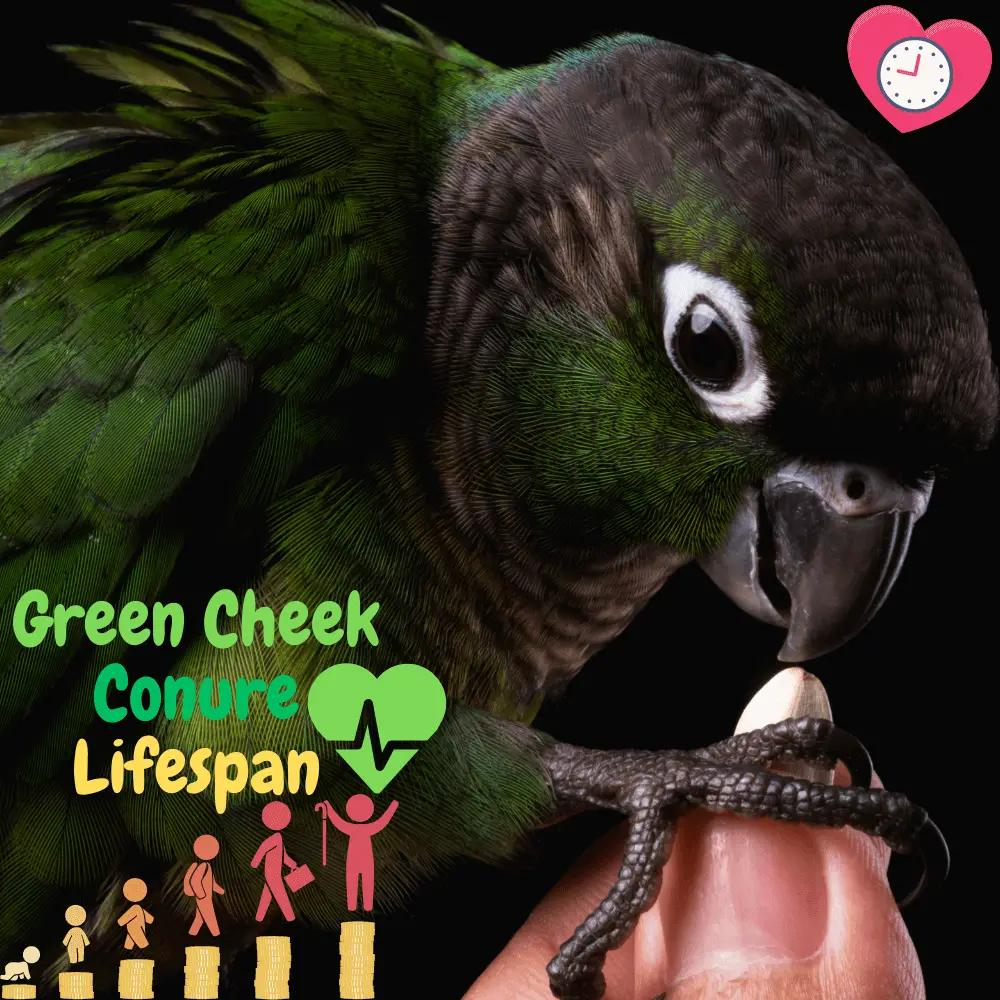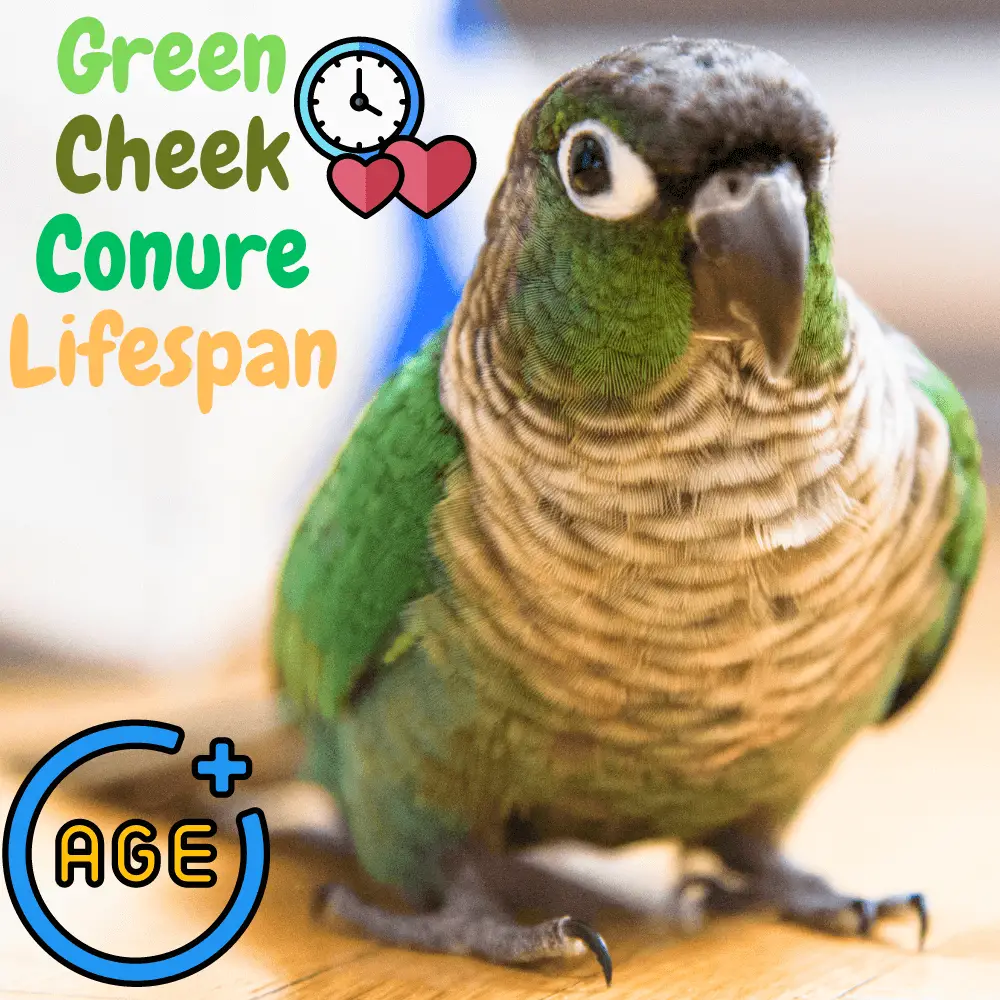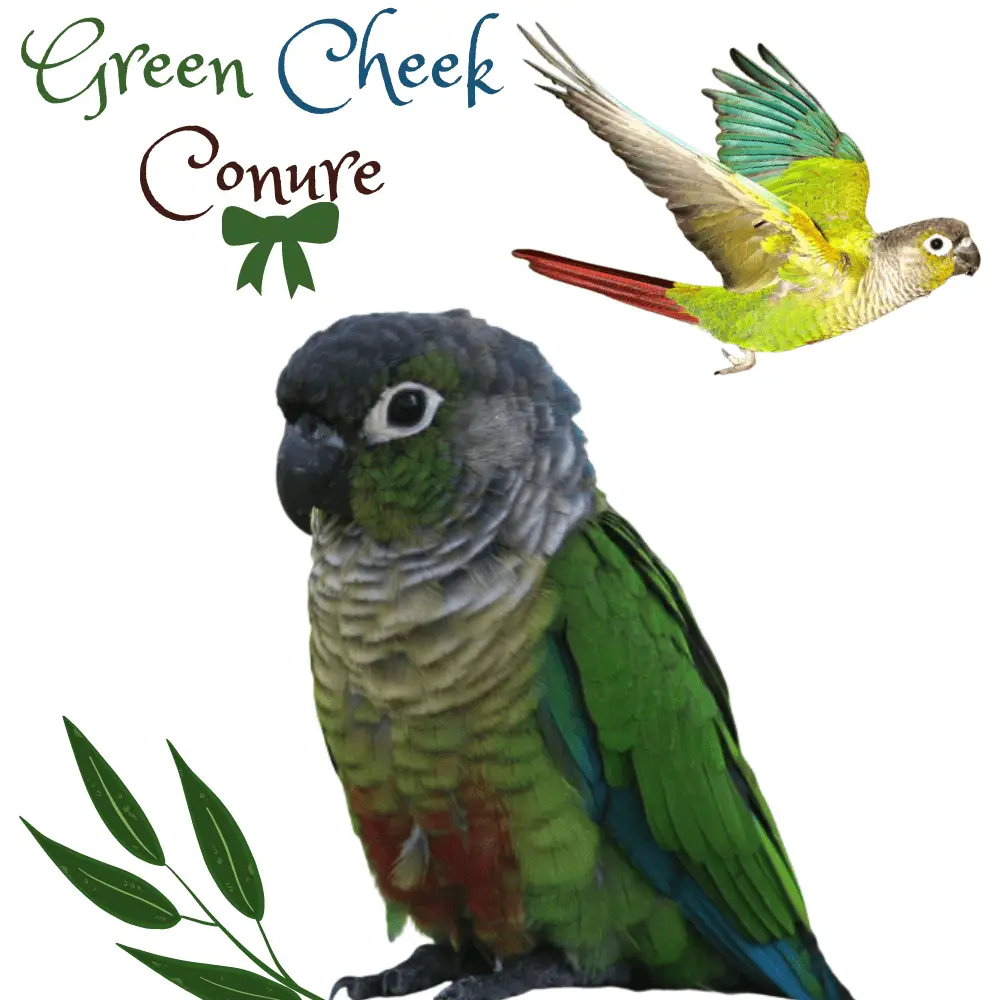
Green cheek conure lifespan This parrot has a life expectancy of about 15-25 years, Green cheek conure is a small to medium-sized parrot known for its playful and affectionate character. They are great pets and can be a source of joy and companionship for many years. In this guide, you’ll learn everything you need to know about parakeets, including behavior, nutrition, health and welfare, care, and maintenance.
It is important to know that there are different types of parrots, such as the sun parakeet, the green-cheeked parakeet, and the Nanday parakeet.
Understanding the behavior of parakeets
Common practices
Like all parrots, parrots have unique personalities and behaviors. Common behaviors include eating, playing with toys, and vocalizations. These behaviors are natural and should be encouraged as they help stimulate the parrot mentally and physically.
Problematic behaviors
However, some behaviors, such as plucking feathers or biting, can be problematic. These behaviors are often the result of stress or boredom and can be remedied with appropriate training and socialization. It is important that you spend a lot of time with your parakeet and provide him with plenty of toys and activities to keep him busy and entertained.
Food and nutrition of the cone bird
Balanced diet
Parrots have special dietary needs that must be met to maintain their health and overall well-being. A balanced diet for a parakeet should consist of various fruits and vegetables, as well as high-quality pellets or seeds. In addition, it is important that the parrot always gets fresh water.
Safe food
Fruits and vegetables that Conurus parrots can eat include apples, berries, green leafy vegetables, and more. It’s important to avoid foods that are toxic to parrots, such as avocados, chocolate, and alcohol.
Health and well-being of parrots
General health problems
Parrot parakeets are generally hardy birds but can be susceptible to some health problems. The most common health problems include feather plucking, respiratory infections, and obesity.
Maintaining well-being
In order to maintain the overall well-being of your parakeet, it is important to provide him with a healthy diet, a clean living environment, and regular veterinary check-ups. It’s also important to pay attention to changes in the behavior or appearance of the Conurus parrot, as these may be signs of an underlying health problem. In addition, it is important to pay attention to general health problems specific to each species of parakeet, such as sun parakeets are prone to feather pecking and beak and feather diseases in psittacines.
Care and maintenance of the parakeet
Proper care
Proper care of parrot parakeets consists of providing them with a clean and safe living environment, grooming them regularly, and providing them with lots of toys and activities to stimulate them mentally and physically.
Living environment
Creating a suitable habitat for the parrot parakeet means that a spacious cage or aviary must be available, as well as a variety of perches and toys. It is also important that the Conurus parrot has access to natural sunlight and fresh air. In addition, it is important to make sure that the size of the cage or aviary is suitable for the particular Conurus species, as the different species have different needs.

Life expectancy Parakeet parrot
The life expectancy of a Conurus parrot can vary depending on the species but is generally between 20 and 30 years. However, with proper care and attention, some parakeets can live up to 40 years or more.
The Sun Conurus, for example, has an average lifespan of 20-30 years. The Green-cheeked Conurus has a life expectancy of about 15-25 years, while the Nanday Conurus has a life expectancy of about 20-30 years.
It’s important to know that the life expectancy of a Conurus parrot can be affected by a number of factors, including diet, exercise, and overall health. A nutrient-dense, low-fat diet free of harmful chemicals can help keep the Conurus parrot healthy and increase its life expectancy. Regular exercise and mental stimulation are also important to maintain the parrot’s overall health and extend its lifespan.
Proper veterinary care is also an essential element to ensure a long and healthy life for your Conuro parrot. Regular check-ups and vaccinations can help prevent and manage health problems.
It is also important to keep in mind that parrots caught in the wild have a shorter life expectancy than those raised in captivity, due to the stress of catching, transporting and changing the environment.
In summary, the life expectancy of a Conurus parrot can vary depending on the species and care. However, with proper care and attention, a Conurus parrot can live 20-30 years or more.
How much does a parakeet cost?
The cost of a Conurus parrot can vary depending on the species, age, and location. Some common Conurus species are the Green cheek conure, the Green-cheeked Conurus, and the Nanday Conurus.
The Sun Conurus, known for its yellow and orange plumage, usually costs between $400 and $800. Known for its small size and playful character, the green-cheeked parakeet usually costs between $200 and $400. The Nanday parakeet, known for its black head and green body, usually costs between $300 and $600.
It is important to know that these prices are estimates only and may vary depending on the location and grower. In addition, the price of a parakeet may be higher if it has been trained or if it is a particularly rare or sought-after species.
It’s also important to consider the ongoing costs of keeping a Conurus parrot, such as food, toys, veterinary care, and cage or aviary maintenance. These costs can accumulate over time and must be taken into account when deciding on the purchase of a Konuro parrot.
Before buying a parrot, it’s important to learn about the different types and find a species that fits your lifestyle, budget, and level of experience. In addition, it is important to buy from reputable breeders or rescue organizations and make sure that the bird is in good health before buying.
How much does a sun-parakeet parrot cost?
The cost of a sun parakeet varies depending on age, location, and whether the bird was bred in captivity or wild-caught. On average, the price of a sun parakeet can range from $400 to $800. However, it can be higher or lower depending on the location and grower.
Captive-bred sun parakeets are usually more expensive than animals caught in the wild. Captive-bred sun rabbits tend to be healthier, receive regular veterinary care, are socialized, and are more suitable for keeping than pets. Captive-bred sun rabbits can cost between $600 and $800.
Wild-bred sun rabbits, on the other hand, are cheaper, but they also come with a number of challenges and risks. Wild sun rabbits may have been caught in the wild, may have been exposed to disease, and may have difficulty adapting to captivity. In addition, they have a shorter life expectancy than captive-raised sun rabbits and can cost $300 to $500.
It is important to remember that the cost of acquiring a sun rabbit is just the beginning, as it is also necessary to take into account the expenses of food, toys, veterinary care, and the maintenance of the cage or aviary. In addition, it is important to buy from reputable breeders or rescue organizations and make sure that the bird is in good health before buying.

How to care for a parrot?
Caring for a parrot requires a healthy diet, a clean living environment, regular grooming, and plenty of toys and activities to stimulate it mentally and physically. Here are some tips that will help you care for your Konuro parrot:
- Nutrition: Parrots have specific nutritional needs that must be met to maintain their health and overall well-being. A balanced diet for a parakeet should consist of various fruits and vegetables, as well as high-quality pellets or seeds. In addition, it is important that the parrot always gets fresh water.
- Habitat: In order to create an adequate habitat for the Conurus parrot, it is necessary to provide it with a spacious cage or aviary, as well as a variety of perches and toys. It is also important that the Conurus parrot has access to natural sunlight and fresh air. In addition, it is important that the size of the cage or aviary is suitable for the particular type of parakeet, as different species have different needs.
- Mental and physical stimulation: Parrots are intelligent birds and need a lot of mental and physical stimulation to stay healthy and happy. Offer your parakeet a variety of toys, puzzles, and activities to keep him entertained. In addition, spend a lot of time with your Konuro parrot, play with it, and interact with it.
- Training and socialization: Conuro parrots can be trained and socialized to get along well with humans and other pets. Training methods with positive reinforcement are the most effective way to train a parrot.
- Care: Parrots need regular care to take care of their plumage, beak, and nails. This can be done by giving them an octopus bone or taking them to a professional dog groomer. It’s also important to check their plumage and skin regularly for signs of parasites or infection.
- Regular veterinary check-ups: Regular veterinary check-ups are important to make sure your parrot is healthy. Your veterinarian can advise you on your parrot’s diet, behavior, and care, and help identify any health problems early.
- Interaction with other pets: Parakeets are social creatures and should be kept together with other parakeets or other compatible birds. Be sure to monitor their interactions with other pets to ensure the safety of both.
It is important to remember that each Conurus parrot is unique and can have different needs and preferences. It is important to observe and know the needs of your particular cone parrot and adapt its care accordingly.
The training of a parrot requires positive reinforcement, perseverance and patience. Here are some tips for training your Konuro parrot:
- Start with the basic commands: First, teach your Konuro parrot the basic commands, such as “Get up,” “Come,” and “No.” Use a unified command and reward him with a treat or praise if he performs the command correctly.
- Use positive reinforcement: Positive reinforcement is the most effective method of training parrots. Use a reward system, such as treats or verbal praise, to encourage your parakeet to repeat desired behaviors.
- Ensure consistent training: Consistency is crucial in the training of a Konuro parrot. Train your bird every day, at the same time and in the same place. This allows the parrot to better understand what is expected of it.
- Be patient: Parrots have their own personality and can be stubborn at times. It is important to be patient and not get frustrated if the Konuro parrot does not react as expected. Remember that training is a process and it takes time to learn new behaviors.
- Socialization of the parrot: Socialization is an important aspect of education. Bring your Konuro parrot into contact with different people, animals, and environments. This will help them develop into well-adapted and confident birds.
- Use clicker training: Clicker training is a popular method used by many bird trainers. A small handheld device, called a clicker, is used to mark the exact moment when the bird performs the desired behavior. This method is particularly suitable for learning complex behaviors because it allows the bird to understand exactly what is expected of it.
- Provide ample opportunity to practice: practice makes perfect. Give your parakeet plenty of opportunities to practice new behaviors. This can be done by incorporating the training sessions into the daily routine, such as during meals or while playing with the bird.
- Incorporate fun activities: Training should be a pleasurable experience for both you and your parrot. Integrate fun activities such as games or puzzles into the training. This will help keep the bird engaged and motivated.
- Avoid punishment: Training methods based on punishment are not effective for parrots and can cause anxiety, aggression, and other behavioral problems. Instead, focus on using positive reinforcement to encourage desired behavior.
- Consult a professional: If you have problems raising your parakeet, you should consult a professional bird trainer or behaviorist. They can advise you and help you develop a training plan tailored to your bird’s specific needs.
Remember that training takes time and patience, but with constant effort and positive reinforcement, you can teach your parrot a number of behaviors and tricks.
Inference
Green cheek conure is small to medium-sized parrots known for their playful and affectionate character. Understanding their behavior, diet, health, well-being, care, and upkeep can help ensure that your Konuro parrot has the best quality of life possible. Remember to always consult a veterinarian in case of special problems to ensure a healthy and safe environment for your Konuro parrot. With proper care and attention, your Konuro parrot can be a loving and entertaining companion for many years to come.
Why I Chose a Green Cheek Conure and Never Will Again
SOURCE:Victoria Ryann
Related Articles:




















